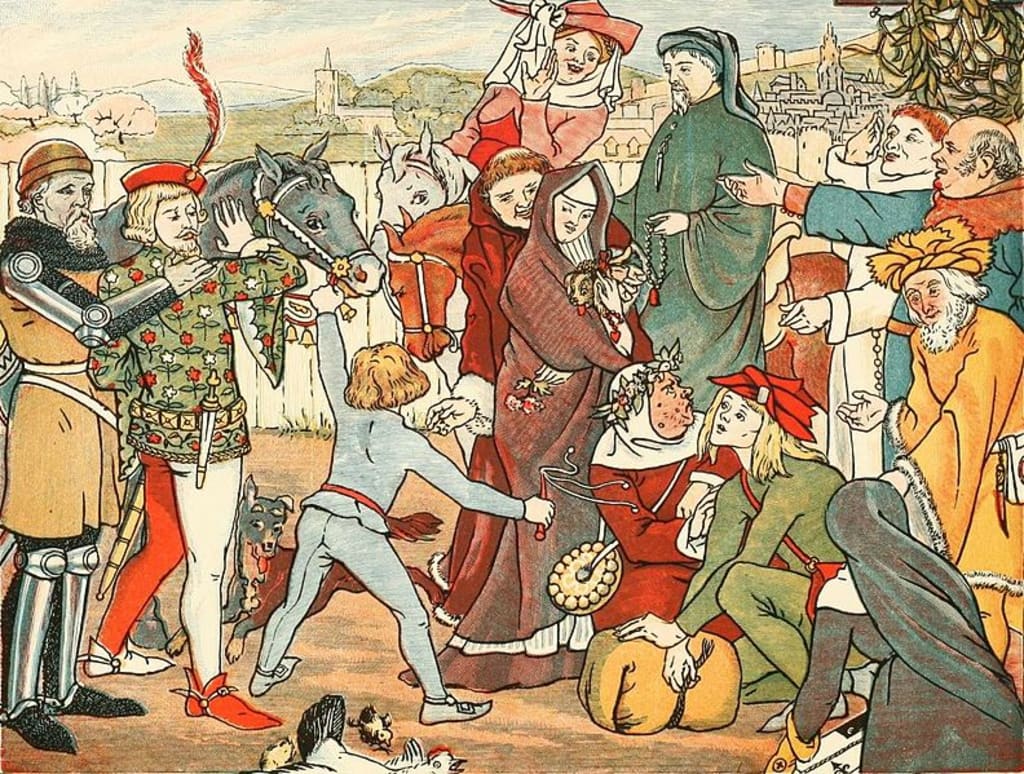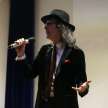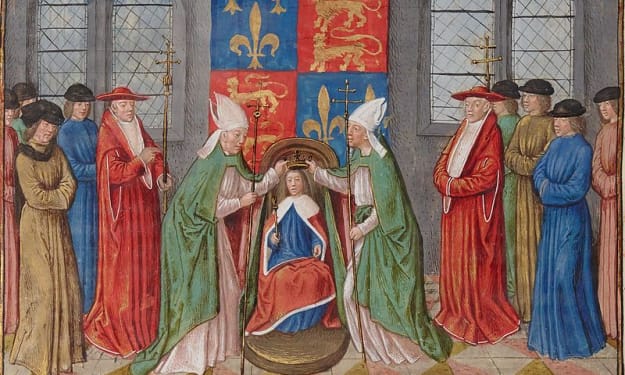
Although Geoffrey Chaucer was not born into the English aristocracy, he was personally known to many of the significant players in the conflicts and upheavals over the British crown that characterized the Middle English Period. Chaucer also lived just long enough to see the deposition of King Richard the Second by Henry the Fourth, which act would ultimately result in years of bloodshed during the Wars of the Roses.
Chaucer’s father was a wealthy wine-merchant who enjoyed high-class trade connections, and it was presumably through these that he arranged for his boy Geoffrey to serve as apprentice in the household of Lionel, Duke of Clarence, son of the then-reigning King Edward the Third. By the late 1350s Chaucer was a young soldier fighting alongside alongside Lionel in the French wars, and was apparently so valued by his master that in 1360 the latter paid Chaucer’s ransom when he had been captured by the enemy. The pattern whereby one brilliant young author successfully crosses the barrier between social classes is seen again and again in the history of English literature, and Geoffrey Chaucer might be said to have begun it.
It was however Lionel’s younger brother John of Gaunt, father of Henry the Fourth, who went on to bear the greatest influence in Chaucer’s life. Gaunt supported Chaucer throughout his career as a poet and they were also related by marriage, for Chaucer’s wife Philippa was the sister of Gaunt’s third wife. Although Philippa died in 1387, Chaucer maintained strong ties with Gaunt’s family for the rest of his life. In 1386 he was made a Member of Parliament for the Shire of Kent, and he also served as royal courtier, diplomat, ambassador, comptroller and forester as well as soldier and poet. Geoffrey Chaucer, in other words, was a man who saw a good deal of life. He died in 1400 and was buried at Poets’ Corner in Westminster Abbey.

Geoffrey Chaucer was unusually well-read, especially for one who lived in an age before printing came to England, and it is said he personally owned an extraordinary number of books by the standards of the time. His extensive reading is of course one of the reasons he was able to write so well. A significant early achievement was his translation into English of La Roman de la Rose (“The Romance of the Rose”), a French poem begun around 1230 by Guillaume de Lorris and finished by Jean de Meun about forty years later. The first great poem by Chaucer himself was The Book of the Duchess, written around 1370. It is widely believed to be about the death of Blanche of Lancaster, first wife of his friend and patron John of Gaunt.
Between 1374 and 1386 Chaucer was working as a customs comptroller in London. This was evidently not a demanding job, for Chaucer seems to have had enough time on his hands to make it one of his most productive periods in terms of poetry. Here he produced The House of Fame, which is a French-inspired dream-poem similar to The Book of the Duchess, and also The Parliament of Fowls and The Legend of Good Women.
Around 1380-85 emerged Troilus and Criseyde, the longest poem Chaucer ever completed. It is widely considered his first masterpiece, and has even been described as “the greatest of romances.” What is now known as the legend of Troilus and Cressida seems to have been invented in Medieval Europe and incorporated into the far older Classical Greek myth of the Siege of Troy, whose best known retelling is Homer’s The Iliad. Chaucer’s poem was itself based on Il Filostrato, a version of Troilus and Cressida’s story by the Italian poet Giovanni Boccacio. Chaucer admired this great contemporary above all other authors, and we’ll hear more about their relationship in just a moment. Lastly, other significant works by Geoffrey Chaucer include A Treatise on the Astrolabe, which is actually a technical manual on how to use an item of Fifteenth-Century astrological equipment. He also wrote a translation of Boethius’s The Consolation of Philosophy, and penned a number of short poems.

Chaucer may have met his inspiration and idol Boccacio in person, for it is known he visited Italy between 1372 and 1373 when the latter was still alive. It’s believed Chaucer may also have arranged an audience with Boccaccio’s countryman Francisco Petracho, better known as Petrarch, when he was there. These two Italians are among a small number of men credited with beginning the upheavals in western art and culture that would culminate in the Renaissance.
Boccaccio’s masterpiece was a book called The Decameron, consisting of one hundred short stories told by ten different subjective narrators. Chaucer greatly admired this text, and by around 1386 had resolved to write a work of his own based upon it. That work would become The Canterbury Tales. Sadly Chaucer never completed this masterpiece, but it is nevertheless regarded as his greatest achievement and one of the landmarks of English literature.
The Canterbury Tales is the story of a group of about thirty men and women from all walks of life and every social class, who set out together from London on horseback one spring day. They are going to the town of Canterbury where they intend to worship at a famous shrine, which is to say the tomb of a famous Christian martyr. Though the shrine Chaucer writes about in The Canterbury Tales no longer exists, there are still many holy places in Great Britain which are still visited by religious travellers to this day. A journey of this kind is called a pilgrimage, so Chaucer’s horseback voyagers are best described as pilgrims.
There is a tavern-landlord named Harry Bailly, who Chaucer apparently based on somebody he knew. Bailly suggests that as the journey will be long, the pilgrims should entertain each other by telling stories on the way. In other words, there is a main story in The Canterbury Tales about thirty or so pilgrims travelling to Canterbury (which we might call the framing narrative) and interwoven with this are the tales themselves. Each pilgrim tells his or her individual story in turn, so that the whole book is arranged into a sequence of many small stories within one. Most of the tales are complete and self-sustaining with their own beginnings, middles and ends, and they can be read either on their own or as part of the whole.

The Canterbury Tales is introduced with a General Prologue, and then we begin to dip in and out of the framing narrative through a series of prologues to each tale. Things steadily become more interwoven still, as Chaucer proceeds to tie each tale to the character who tells it. We learn much about the sort of person each pilgrim is from the story he or she shares. Additionally, back in the framing narrative the characters argue, offend each other, and reveal their innate prejudices. These conflicts also influence the tales they tell. Though The Canterbury Tales is based on Boccaccio’s Decameron, this ongoing interplay between the framing narrative and the short stories themselves is wholly Chaucer’s innovation.
Nor is that the only way in which Chaucer breaks new ground with his Canterbury Tales. The earliest works of English literature tend towards depicting a land of heroes – Beowulf, King Arthur, Sir Galahad and so on. Literary characters of this stamp might suggest a preoccupation with physical and moral heroics that any ordinary person would find difficult to live up to. It’s those everyday citizens who are absent from our early tales of high adventure and mystical forces, but as we move from the beginnings of the Middle English period to its end, the common man starts to achieve literary representation at last. In a very real sense, this begins with Geoffrey Chaucer and The Canterbury Tales.






Comments (3)
Oh wow, this was all so fascinating! Also, the Gaunts family reminded me of the Gaunts family from Harry Potter!
Very interesting. Thanks for sharing, Doc.
Fabulously written & fantastic read!!! ❤️❤️💕